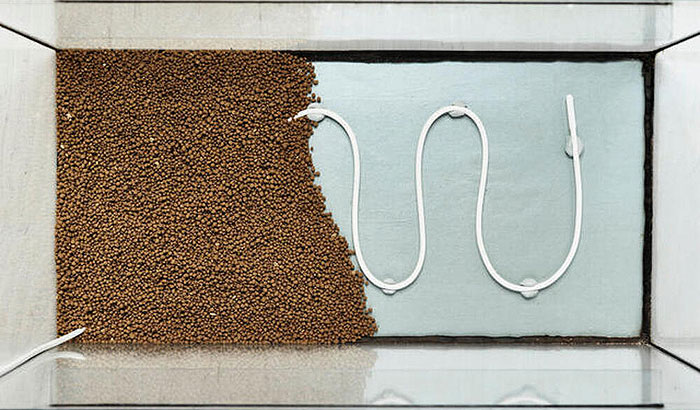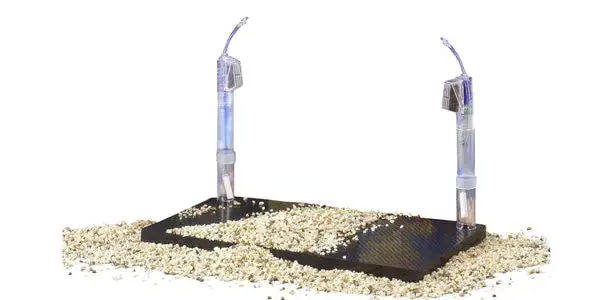Undergravel filters work by using a plastic plate with small holes throughout the bottom of an aquarium. This plate is held in place either by gravel or silicone, and contains a lift tube. Water enters the tank and is drawn down through the substrate into this lift tube where it is then pushed up out of the water column, filtered and then returned to the tank.
The substrate works as a mechanical filter trapping particles that are larger than its pores while beneficial bacteria living in it help break down organic waste in addition to providing biological filtration. This type of filter also helps promote adequate oxygenation as water passes over rocks which increases aeration levels within an aquarium.
Undergravel filters are a type of filtration system used to help keep your fish tank clean and healthy. They work by allowing water to pass through the gravel substrate where it is then filtered. The filter works by trapping debris, dirt, and other particles in the gravel which can then be removed from the tank if needed.
This type of filter also helps promote beneficial bacteria growth that helps break down ammonia and nitrates in the water. Undergravel filters are great for those who want an effective way to keep their aquariums clean without having to do too much maintenance or change out parts every few weeks.
Fish Tank Filter Showdown: Under Gravel Filter vs Sponge Filter!
Undergravel Filter Pros And Cons
Undergravel filters are a popular choice for aquarium filtration, with many advantages and some potential drawbacks. One of the main benefits of an undergravel filter is that they are relatively inexpensive compared to other types of filtration systems. They also require minimal maintenance, as they don’t have any moving parts or mechanical components that need replacing over time.
Additionally, this type of filter can help create a healthy environment in your tank by providing oxygen-rich water circulation and helping remove debris from the substrate. On the downside, these filters do not provide chemical filtration and may become clogged easily if not maintained properly.
Undergravel Filter Setup
Undergravel filters are a popular and effective choice for aquarium filtration. They consist of an inverted gravel bed beneath the tank’s substrate that is connected to a power filter, air pump or canister filter. The water from the tank siphons through the gravel bed, trapping debris and uneaten food particles in its nooks and crannies.
This trapped detritus is then collected by the filter system for disposal, leading to cleaner and healthier water for your fish. Setting up an undergravel filter requires some basic equipment including an appropriate-sized aquarium, substrate such as sand or gravel, a powerhead or other type of pump/filter unit and tubing to connect it all together; however, once installed it will provide reliable filtration with minimal maintenance required.
How to Clean under Gravel Filter
Cleaning under your gravel filter is an important part of proper aquarium maintenance. To do this, start by turning off the power to the filter and removing it from the tank. Then, use a siphon to vacuum out any debris that has collected on top of the gravel layer.
Once all visible debris is removed, rinse the gravel with water before returning it to its original place in the aquarium. Finally, reinstall your filter and turn it back on so that your tank can be filtered again!
Under Gravel Filter 55 Gallon
An Under Gravel Filter 55 Gallon is an effective, economical way to filter up to 55 gallons of aquarium water. It consists of a gravel bed placed under a layer of coarse plastic mesh that sits atop the aquarium substrate. Water passes through the gravel and into the mesh where it is collected and returned to the tank via an air pump or powerhead.
This type of filter can provide excellent filtration by trapping large particles before they reach your other filtration media such as activated carbon and mechanical filters.
Under Gravel Fish Tank Filter 20 Gallon
Under Gravel filters are a great choice for a 20 gallon tank. They effectively filter out debris and waste from the water column, while allowing beneficial bacteria to colonize in the gravel substrate. The gravel also creates an oxygen-rich environment that helps promote healthy fish growth, making it ideal for beginner aquarists who want to keep their aquatic inhabitants happy and healthy.
Under Gravel Fish Tank Filter 5 Gallon
Under Gravel Fish Tank Filters are an excellent choice for smaller 5 gallon aquariums as they provide effective biological filtration at a low cost. This type of filter is placed beneath the gravel substrate and utilizes an air pump to draw water through it, trapping debris and allowing beneficial bacteria colonies to develop. This provides complete filtration for your fish tank while consuming very little energy and maintenance.
Do Undergravel Filters Work With Sand
Undergravel filters are a great choice for aquariums with sand substrates. The filter consists of a grate that is placed at the bottom of the tank, under the substrate. The water flows through this grate and into an attached pump, allowing debris and waste to be filtered out while still allowing beneficial bacteria to flourish in the substrate below.
This type of filtration works well with both fine or course sands and can provide excellent mechanical, biological, and chemical filtration for your tank!
Best Undergravel Filter Setup
Undergravel filters are an excellent choice for aquariums of all sizes. They offer a low-maintenance solution to tank filtration, as well as a natural look and feel to your tank. When set up correctly, undergravel filters can provide thorough biological and mechanical filtration for your aquarium.
The best setup involves placing the filter plate on the bottom of the tank, adding gravel over it that is 1 inch thick or more, then running an air pump with airline tubing connected to each corner of the filter plate. This will create water flow throughout the gravel bed and help keep your tank clean and healthy.

Credit: www.aquatic-eden.com
Why Don’T People Use under Gravel Filters Anymore?
The use of under gravel filters in aquariums has significantly decreased over the years for several reasons. First, these types of filters are not as effective at cleaning and filtering water compared to other filter systems such as canister or hang-on-back filters. This is because they don’t provide enough surface area for beneficial bacteria to colonize and effectively remove toxins from the aquarium water.
Additionally, under gravel filters often need regular maintenance that can be difficult if you have a large tank with lots of fish or plants. Finally, under gravel filters are relatively inexpensive but still more costly than alternative filtration solutions on the market today which makes them less desirable for many hobbyists. All in all, although some people may choose to use an undergravel filter due to its simplicity and lower cost than other filtration options, most hobbyists opt for more efficient alternatives when it comes to keeping their tanks clean and safe for their aquatic inhabitants.
What are the Benefits of Undergravel Filter?
Undergravel filters are a popular choice for aquarium owners who want to create healthy and aesthetically pleasing habitats for their fish. This type of filtration system works by drawing water from the tank through slots in the bottom plate, which is covered with gravel or another substrate material. As the water passes through these materials, particles and other debris are trapped in the substrate, allowing only clean water to pass back into the tank.
The benefits of using an undergravel filter include improved water quality, clearer visibility in your tank, less frequent maintenance requirements, enhanced biological filtration capabilities, more oxygenation throughout your aquarium environment and increased circulation of beneficial bacteria that help break down waste products. Additionally, many aquarists choose this type of filter because it helps reduce nitrates and phosphates in their tanks while providing a safe home for beneficial live plants like java moss or dwarf hair grasses that can thrive without needing additional lighting or fertilizers. Ultimately, undergravel filters offer a cost-effective way to maintain healthier aquariums with fewer hassles!
How Do You Maintain an Undergravel Filter?
Maintaining an undergravel filter is important to ensure your aquarium stays clean and healthy. The first step in maintaining an undergravel filter is to remove any debris from the gravel bed, as this can clog up the filter and impede its effectiveness. You should also check for clogs or blockages in the tubes, vents, or other components of the system and clear them out if necessary.
Once a month or so you should also perform a deep cleaning process on your filter by taking it apart and soaking all parts in warm water with a mild detergent before rinsing everything off thoroughly. Additionally, you’ll want to make sure that airstone valves are working properly so they are able to provide adequate oxygenation without allowing too much waste material into your tank. Finally, it’s essential that you regularly monitor ammonia levels as well as pH levels within your tank; if either becomes too high then it could indicate that there may be problems with your filtration system which need addressing quickly.
With regular maintenance and monitoring of these elements, you can maintain an effective undergravel filter for years!
Do You Need an Air Pump for under Gravel Filter?
Yes, an air pump is necessary for any under gravel filter system to function properly. The air pump pumps oxygenated water through the gravel, which helps to keep fish and other aquatic life healthy by increasing oxygen levels in the aquarium. An air pump also helps prevent dead spots where harmful bacteria can grow unchecked, as well as promoting beneficial bacterial growth that breaks down waste materials in your tank.
Furthermore, an air pump assists with water circulation throughout your aquarium setup and it can help reduce or eliminate unpleasant odors caused by stagnant water. When choosing an air pump for your under gravel filter system be sure to select one powerful enough to meet the needs of your particular tank size and inhabitants; a good rule of thumb is two times the volume of water present in the tank per hour should be able to adequately circulate all areas of the aquarium with fresh oxygen-rich water.
Conclusion
Undergravel filters are a great option for aquarists who want to keep their water clean and healthy without spending too much money. They provide an effective filtration system that is easy to maintain, making them ideal for both beginner and experienced hobbyists alike. With the right setup, they can help create a safe and stable environment in your tank while providing additional biological filtration benefits like nitrate removal.
As long as you take the time to research how these filters work, choose the appropriate size for your aquarium, and perform regular maintenance tasks, then you can be sure that your undergravel filter will serve you well in keeping your fish happy and healthy!

